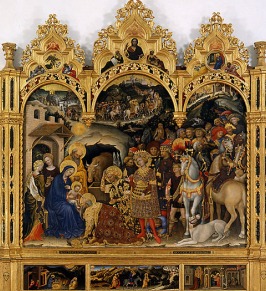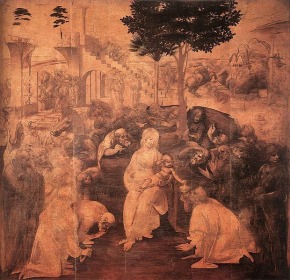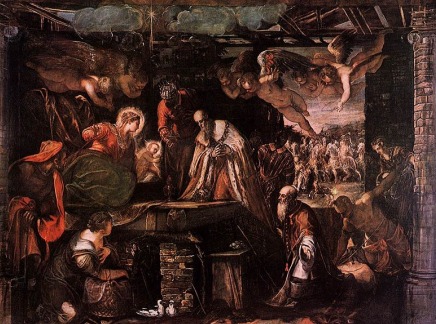
In the Gospel of Matthew, “wise men (magi) from the East” come to Jerusalem after the birth of Christ, asking, “Where is he who has been born king of the Jews? We saw his star rising in the East and have come to worship him.” (Matt 2:1–2) Matthew goes on to record their dialogue with Herod and arrival in Bethlehem with gifts for the child. But the Gospel says no more about the identities of the Eastern visitors. Who were these strangers who traveled such a long way to see a Jewish baby? What did they make of him?
Matthew says, “They fell down and worshipped him” (2:11). Tradition holds that, as the shepherds were Jews, the magi were the first gentiles to recognize and acknowledge the divinity of Christ. Martin Luther disagreed: “They honored him as a king,” he declared in a sermon on that passage. “Nor was the worship like that done to God because, in my opinion, they did not recognize him as God.” Luther cautioned against speculating on further details about the magi’s visit. “What conversation they had with Mary and Joseph I leave to the imagination of idle minds.”
Fortunately, both before and after Luther had his say, many artists set their minds to imagining the scene of the magi’s visit to Bethlehem. Most medieval and Renaissance painters, following a tradition that linked the episode to an Old Testament passage, made the wise men look like kings. As craftsmen who depended for their living on wealthy patrons, artists must have relished the compelling, dramatic image of richly dressed royalty bowing down to a poor child. The paintings include more people looking on than do typical depictions of the shepherds’ adoration. Images of the magi tend to be crowded, complicated, even confused, perhaps reflecting uncertainty about the meaning of their visit—the universal welcome it promised, but also the violence and suffering it unleashed.
 Gentile da Fabriano’s Adoration of the Magi is so crammed with rich figures, fabric, and gold that it seems to be in competition with the wise men’s first-mentioned gift. Everything about this sumptuous Gothic altarpiece glitters with regality. Mary sits as if on a throne with two waiting women behind her; Joseph stands faithfully by her side, as the infant Jesus reaches out and blesses the first king. The gorgeously habited visitors from the east, sometimes pictured as representative of different regions or races, look instead like the three ages of man. The oldest kisses the feet of the child; the middle-aged one is about to remove his crown; the youngest, in short embroidered tunic and bright red hose, is having his spurs removed by a servant who is crouching lower behind his master than the first king before Jesus. Even the horses and the muzzled hound look suave and noble. A crowd of colorful attendants and spectators press forward as if hoping to have their picture taken at a historic event. Exotic creatures—two monkeys, a lion, a tiger, and several quarrelsome birds—seem to have come along for the ride. The background shows an earlier moment, with the procession of the kings winding its way picturesquely up a hill toward the walls of the town. The triple-arched gilt frame crowns the scene, incorporating a biblical episode into the formal ritual and splendor of the church.
Gentile da Fabriano’s Adoration of the Magi is so crammed with rich figures, fabric, and gold that it seems to be in competition with the wise men’s first-mentioned gift. Everything about this sumptuous Gothic altarpiece glitters with regality. Mary sits as if on a throne with two waiting women behind her; Joseph stands faithfully by her side, as the infant Jesus reaches out and blesses the first king. The gorgeously habited visitors from the east, sometimes pictured as representative of different regions or races, look instead like the three ages of man. The oldest kisses the feet of the child; the middle-aged one is about to remove his crown; the youngest, in short embroidered tunic and bright red hose, is having his spurs removed by a servant who is crouching lower behind his master than the first king before Jesus. Even the horses and the muzzled hound look suave and noble. A crowd of colorful attendants and spectators press forward as if hoping to have their picture taken at a historic event. Exotic creatures—two monkeys, a lion, a tiger, and several quarrelsome birds—seem to have come along for the ride. The background shows an earlier moment, with the procession of the kings winding its way picturesquely up a hill toward the walls of the town. The triple-arched gilt frame crowns the scene, incorporating a biblical episode into the formal ritual and splendor of the church.
Fabriano’s golden magi look like prosperous European kings and princes instead of Eastern wise men. His painting is a celebration of the deference of institutional wealth and power to the Christ child, while at the same time the well-dressed visitors nearly crowd Jesus and his mother out of the picture.
After his conversion to the Church of England in 1928, T. S. Eliot wrote “The Journey of the Magi” (1930), a narrative poem, more disturbing than celebratory, in which one of the magi recalls the trip grimly and the discovery of the child as darkly unsettling:
“A cold coming we had of it,
Just the worst time of the year
For a journey, and such a long journey:
The ways deep and the weather sharp,
The very dead of winter.”
After more complaining, he remembers coming to a “temperate valley” and a tavern,
But there was no information, and so we continued
And arrived at evening, not a moment too soon
Finding the place; it was (you may say) satisfactory.
All this was a long time ago, I remember,
And I would do it again, but set down
This set down
This: were we led all that way for
Birth or Death? There was a Birth, certainly,
We had evidence and no doubt. I had seen birth and death,
But had thought they were different; this Birth was
Hard and bitter agony for us, like Death, our death...
There is no mention of worshipping in Eliot’s poem, although his magi do seem to have recognized that something of mysterious import and, for them, shattering consequence had happened in the stable. If they were sorcerers or astrologers, they were about to be put out of business. If they were, for Eliot, representatives of a “world” of false hopes and idols, like the unholy prin-ces of modern Europe on the verge of war in the 1930s, they could foresee in the child’s coming not only that he would eventually ruin them but that they would do their best to try to ruin him.
Although not by any means as dark as Eliot’s poem, the most mysterious, unsettling painting of the Adoration of the Magi, the one that raises the most questions and shows a world in turmoil beyond the manger, is a great unfinished work by Leonardo da Vinci.
 While the central figures of Mary and Jesus form an exquisitely serene focal point, everyone and everything around them, except the stalwart palm tree, is in a state of frenzied disarray. Even the magi, bearded old men with no crowns, keep their distance, hover and cringe as much in fear as in reverence. Baby Jesus receives a gift from one of them with princely aplomb, while Mary sits unfazed by the commotion around her. Her shapely right foot seems to “hold the line,” keeping her and the infant on her knee from spinning in the whirl of their surroundings.
While the central figures of Mary and Jesus form an exquisitely serene focal point, everyone and everything around them, except the stalwart palm tree, is in a state of frenzied disarray. Even the magi, bearded old men with no crowns, keep their distance, hover and cringe as much in fear as in reverence. Baby Jesus receives a gift from one of them with princely aplomb, while Mary sits unfazed by the commotion around her. Her shapely right foot seems to “hold the line,” keeping her and the infant on her knee from spinning in the whirl of their surroundings.
Leonardo, commissioned to paint an altarpiece by the Augustinian monks of San Donato a Scopeto, near Florence, did many preparatory sketches, but, perhaps because the brothers stopped paying him, or because he became dissatisfied with his work, he never completed the painting. In many ways, the suggestive, tentative, unfinished quality of the picture endows it with a haunting complexity beyond what Eliot’s poem darkly suggests. In the background there are steps leading nowhere and horsemen furiously battling one another. The crowd around Mary and Jesus looks in part like a mob on the verge of hysteria or a throng caught in a violent storm. An old man stands at left, stroking his chin. Could that be Joseph? Or a prophet? On the right a young man (thought to be a self-portrait of the artist) looks away. Somehow, through it all, through the possible arrangements and rearrangements, through odd combinations of shadow and sublime clarity, Leonardo displays an astonishing depth of focus and feeling, an unexpected reordering of perspective, a new and mysterious harmony.
Leonardo’s Adoration seems strangely original and modern in part because it is such an arresting combination of the familiar and odd, the reverent and subversive, the coherent and incoherent. It seems to borrow bits and pieces of architecture, anatomy, and landscape from art and nature, and put them together in startling ways. Although not nearly so ambitious or great a work as Leonardo’s painting, Eliot’s poem also challenges conventional perspective, juxtaposing the gospel story with the bitter memory of one of the magis, and with lines from a sermon by one of England’s great seventeenth-century preachers. On Christmas Day 1622, Lancelot Andrewes preached at Whitehall before King James I. His subject was the journey of the magi:
A cold coming they had of it at this time of the year, just the worst time of the year to take a journey, and specially such a long journey in. The ways deep, the weather sharp…the very dead of winter.
With quotation marks but no citation, Eliot uses Andrewes’s words to begin his poem. However, his wise man takes a very different turn and tone from that of the inspired preacher, who continued:
And these difficulties they overcame, of a wearisome, irksome, troublesome, dangerous, unseasonable journey; and for all this they came. And came it cheerfully and quickly.
The preacher urges the king and congregation to imitate the magi and hurry toward Jesus. And Andrewes wonders, as Eliot later did, whether the travelers, finding Jesus in poverty, will be sorry they came:
Will they not step back at the sight, repent themselves of their journey, and wish themselves at home again? But so find Him, and so finding Him, worship Him for all that? If they will, verily then great is their faith. This, the clearest beam of all.
There is no danger that the Christ child in Tintoretto’s Adoration of the Magi will be lost in the clutter or the crowd. Although the painting is dark and detailed, little Jesus shines brightly as he lunges toward one of the magi’s gifts, a vessel near the center of the picture. Mary shines too; she is a full-bodied woman, not sitting sedately like a queen, but lurching forward like a mother to keep her child from falling.
 The scene nevertheless reflects regality amid the poverty of the setting. Mary and Jesus are on a kind of altar, stage, or platform; to the left they are attended by Joseph in a red scarf and a woman (a lady-in-waiting?) crouching by a basket and two turtle doves. Two of the magi, having already set their gifts before the child, are bareheaded and kneeling; the third is bending over to place his gift with the others, presumably then to remove his crown and kneel like his companions. The wise man kneeling on the ground is dressed in the robes of a prince of the church; the kneeling figure on the platform wears the ermine cape of a doge. The standing wise man may be a foreigner, but Tintoretto leaves little doubt that representatives of the two greatest powers in his world—Rome and Venice—are paying homage to the child as they would not have done—bareheaded and on their knees—before an ordinary king.
The scene nevertheless reflects regality amid the poverty of the setting. Mary and Jesus are on a kind of altar, stage, or platform; to the left they are attended by Joseph in a red scarf and a woman (a lady-in-waiting?) crouching by a basket and two turtle doves. Two of the magi, having already set their gifts before the child, are bareheaded and kneeling; the third is bending over to place his gift with the others, presumably then to remove his crown and kneel like his companions. The wise man kneeling on the ground is dressed in the robes of a prince of the church; the kneeling figure on the platform wears the ermine cape of a doge. The standing wise man may be a foreigner, but Tintoretto leaves little doubt that representatives of the two greatest powers in his world—Rome and Venice—are paying homage to the child as they would not have done—bareheaded and on their knees—before an ordinary king.
Whether or not the figures in the painting see the squadron of angels hovering above, the viewer cannot miss them or the way their wings and the parting clouds form a canopy over mother and child, letting the clear beam of the star shine through. What glitters is the star, the child, the mother, not the gold offered as a gift. Galloping horses and a leaping dog can be seen to the right outside the door. Perhaps they are the attendants of the magi; perhaps they are the troops of Herod. They may be signs of the “world” that will reject and crucify Jesus, but they are pale, ghostly, unreal. Tintoretto’s reality is the bright child in the dark, broken space, leaping from the arms of the big woman. Amid the chaos, he shines, “the clearest beam of all.”
This essay is adapted from a forthcoming book examing the Gospels through the eyes of artists and poets.

